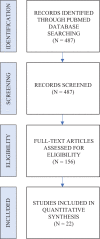Use of Opioids in the Early Postoperative Period After Arthroscopic Rotator Cuff Repair: A Systematic Review
- PMID: 35898204
- PMCID: PMC9310229
- DOI: 10.1177/23259671221112086
Use of Opioids in the Early Postoperative Period After Arthroscopic Rotator Cuff Repair: A Systematic Review
Abstract
Background: Postoperative treatment plans after orthopaedic procedures frequently include opioids for pain relief.
Purpose: To evaluate opioid use in the early postoperative phase after arthroscopic rotator cuff repair (ARCR) to develop a procedure-specific understanding of the current role of opioids in pain management for this procedure.
Study design: Systematic review; Level of evidence, 4.
Methods: A PubMed search was used to identify eligible studies. Data on patient demographics, visual analog scale pain scores, and opioid use patterns (in morphine milligram equivalents [MMEs]) were collected and assessed. Cumulative MMEs were reported on postoperative day (POD) zero, and mean MMEs were reported on subsequent PODs (days 1, 2, 3, 5, 7, and 14). Metaregression, I 2 indices, and Cochran Q tests were used to evaluate study variation, heterogeneity, and variance.
Results: A total of 1487 patients in 22 studies were included in the analysis. An estimated 51% (95% CI, 31%-70%) of patients with nerve blocks (NBs) were opioid-free through POD-0 versus 40% (95% CI, 1.2%-97%) of patients without NBs, which increased to 65% (95% CI, 55%-74%) versus 25% (95% CI, 1.7%-86%) by POD-1. Opioid requirements were highest in the first 72 hours after ARCR. NB use reduced opioid requirement on POD-0 compared with no NB use (15.8 vs 45.0 MMEs, respectively; P < .001) but did not reduce requirements after that. In addition, NB use led to a statistically significant increase in opioid requirements on POD-7 (28.6 vs 9.5 MMEs, respectively; P < .001). Using a model that assumes stable opioid requirements between our time points, weighted mean cumulative opioid consumption was 163 MMEs in the first week and 273 MMEs in the first 2 weeks (150 and 287 MMEs in patients with NB; 180 and 261 MMEs in patients without NB, respectively).
Conclusion: Opioid use is relatively common in the early postoperative period after ARCR. Pain scores and opioid requirements may spike on POD-1; however, patients should be educated and reassured that they will gradually decrease usage over the initial 2-week postoperative period.
Keywords: opioid; orthopaedics; pain; rotator cuff; surgery.
© The Author(s) 2022.
Conflict of interest statement
One or more of the authors has declared the following potential conflict of interest or source of funding: J.C.D. has received hospitality payments from Stryker. N.P. has received consulting fees from Mitek. AOSSM checks author disclosures against the Open Payments Database (OPD). AOSSM has not conducted an independent investigation on the OPD and disclaims any liability or responsibility relating thereto.
Figures



References
-
- American Academy of Orthopaedic Surgeons (AAOS). American Academy of Orthopaedic Surgeons Management of Rotator Cuff Injuries Evidenced-Based Clinical Practice Guideline. AAOS; 2019. https://www.orthoguidelines.org/topic?id=1027
-
- Balocco AL, Van Zundert PGE, Gan SS, Gan TJ, Hadzic A. Extended release bupivacaine formulations for postoperative analgesia: an update. Curr Opin Anaesthesiol. 2018;31(5):636–642. - PubMed
-
- Bang SR, Yu SK, Kim TH. Can gabapentin help reduce postoperative pain in arthroscopic rotator cuff repair? A prospective, randomized, double-blind study. Arthroscopy. 2010;26(9)(suppl):S106–S111. - PubMed
-
- Barry GS, Bailey JG, Sardinha J, Brousseau P, Uppal V. Factors associated with rebound pain after peripheral nerve block for ambulatory surgery. Br J Anaesth. 2021;126(4):862–871. - PubMed
-
- Borgeat A, Aguirre J, Marquardt M, Mrdjen J, Blumenthal S. Continuous interscalene analgesia with ropivacaine 0.2% versus ropivacaine 0.3% after open rotator cuff repair: the effects on postoperative analgesia and motor function. Anesth Analg. 2010;111(6):1543–1547. - PubMed
Publication types
LinkOut - more resources
Full Text Sources
Research Materials
Miscellaneous

